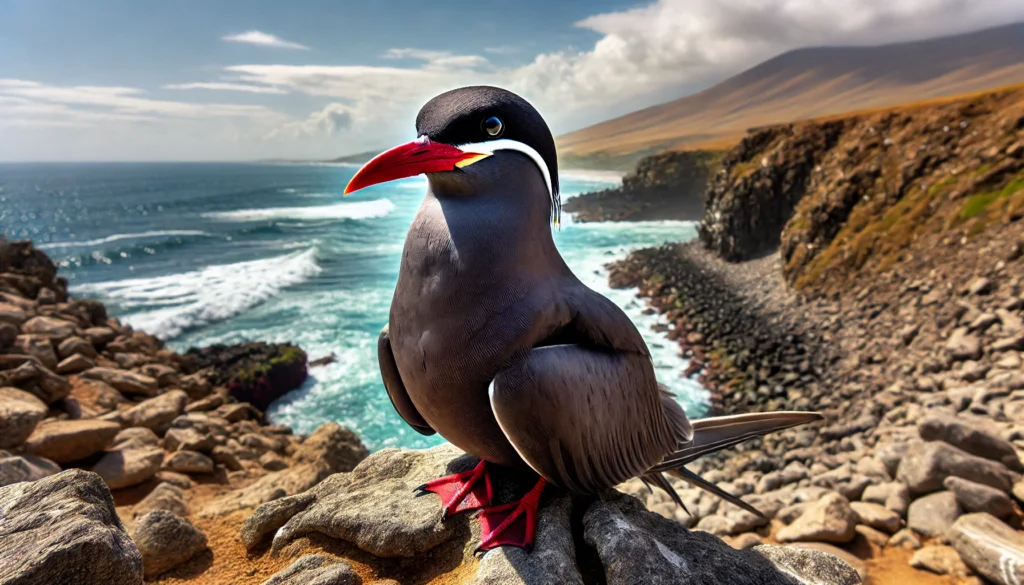The Inca Tern (Larosterna inca) is one of the most strikingly unique and beautiful seabirds found along the Pacific coast of South America. Known for its distinctive appearance and intriguing behaviors, this bird is native to the coasts of Peru and Chile. Here, we dive into five fascinating facts about the Inca Tern that highlight its extraordinary traits and the environment it thrives in.
A Unique ‘Mustache’ for Identification
One of the most remarkable features of the Inca Tern is the pair of elegant white feathers on its face, which curl downward like a mustache. This unique characteristic distinguishes it from other seabirds and adds to its iconic appearance. But these feathers aren’t just for show. Research suggests that the size and prominence of this mustache may serve as an indicator of health and fitness in the species. Inca Terns with larger, more well-defined mustaches are often healthier and more likely to attract mates. This feature sets the Inca Tern apart, making it a visually fascinating bird to observe along the rugged coastline.
The bird’s dark, slate-gray plumage provides a sharp contrast to the vivid red of its beak and legs, further enhancing its distinctive look. In a world where most seabirds are white or gray, the Inca Tern stands out dramatically, earning admiration from birdwatchers and researchers alike.
Native to the Humboldt Current
The Inca Tern is closely associated with the Humboldt Current, a cold oceanic current that flows along the western coast of South America, particularly in Peru and Chile. This current brings nutrient-rich waters to the surface, which supports a thriving ecosystem of marine life, including the Inca Tern’s favorite prey—fish, particularly anchovies. The Humboldt Current plays a vital role in the bird’s survival, offering a bountiful supply of food that sustains large colonies along the coasts.
The tern’s foraging behavior is closely linked to this dynamic environment. Inca Terns are excellent fishers, often seen diving gracefully into the ocean from great heights to catch fish near the surface. The bird’s sharp eyesight allows it to spot schools of fish while flying above the water, and its streamlined body enables it to plunge into the water with precision. This reliance on the Humboldt Current makes the Inca Tern a key species in understanding the health of this marine ecosystem.
An Agile and Social Flyer
Inca Terns are highly social birds that live and breed in large colonies, sometimes numbering in the tens of thousands. They are known for their incredible agility in flight, performing acrobatic twists and turns as they soar along the coastal cliffs. This impressive aerial skill is not only vital for hunting but also for social interactions within the colony. Inca Terns are often seen engaging in playful flights, chasing one another and performing synchronized maneuvers.
Their social nature extends to their nesting habits as well. Inca Terns typically nest in crevices or burrows along rocky cliffs, often in close proximity to other birds. The colonies provide a safe environment where they can raise their young, away from many land-based predators. These cliffs also give them an ideal vantage point to watch for predators and prey in the surrounding waters. The tern’s gregarious nature makes it one of the more visible and vocal seabirds, adding to the rich biodiversity of the coastal regions where they reside.
A Diet Rich in Anchovies
The Inca Tern’s diet is primarily made up of small fish, especially anchovies. Anchovies, abundant in the nutrient-rich waters of the Humboldt Current, are a crucial food source for the tern. The bird uses its sharp, pointed beak to snatch fish from just below the water’s surface during its swift dives. In fact, the feeding habits of Inca Terns are a good indicator of the health of anchovy populations, making these birds valuable bioindicators for marine scientists studying the region’s ecosystem.
In addition to fish, Inca Terns may also feed on crustaceans and other small marine organisms, but anchovies remain their primary food source. Interestingly, the abundance of fish in the Humboldt Current supports not only the Inca Tern but also a wide array of other marine life, including penguins, sea lions, and larger predatory birds. The tern’s reliance on fish underscores the delicate balance within this ecosystem, where changes in fish populations could have cascading effects on other species, including the Inca Tern itself.
Conservation Status and Threats
Although the Inca Tern is not currently classified as endangered, its population faces several threats that could impact its long-term survival. Habitat destruction, particularly along coastal areas, is one of the primary concerns for conservationists. Human activities such as coastal development and mining have led to the degradation of some nesting sites. Additionally, overfishing of anchovies and other small fish, driven by the commercial fishing industry, poses a significant threat to the bird’s food supply.
Another growing concern is the impact of climate change on the Humboldt Current. Changes in ocean temperatures and currents could disrupt the flow of nutrients that sustain fish populations, indirectly affecting the Inca Tern and other species that depend on these waters. Conservation efforts are being made to monitor and protect the tern’s habitat, particularly in Peru and Chile, where the largest colonies are found. These efforts include establishing marine protected areas and regulating fishing activities to ensure the sustainability of fish stocks.
Despite these challenges, the Inca Tern remains a resilient species, with its population currently stable across much of its range. However, continued vigilance and conservation measures will be essential to safeguarding the future of this fascinating bird.
Conclusion
The Inca Tern is not just another seabird; it is a remarkable species with unique adaptations and behaviors that make it stand out in the avian world. From its iconic white mustache to its agile flight and strong connection to the Humboldt Current, this bird exemplifies the incredible diversity of life along South America’s Pacific coast. As we continue to study and protect the ecosystems in which it thrives, the Inca Tern will remain an important symbol of the rich natural heritage of the region.
FAQs
What makes the Inca Tern’s appearance unique?
The Inca Tern is easily recognizable by its dark gray feathers, vivid red beak and legs, and most notably, its striking white mustache-like feathers that curl down from either side of its face.
Where can Inca Terns be found?
Inca Terns are native to the Pacific coasts of Peru and Chile, where they live along the rugged cliffs and islands near the Humboldt Current.
What do Inca Terns eat?
The primary diet of the Inca Tern consists of small fish, particularly anchovies. They also feed on crustaceans and other small marine creatures found near the surface of the ocean.
How do Inca Terns hunt?
Inca Terns are skilled hunters that dive into the water to catch fish. They spot their prey from above while flying and then plunge into the water to snatch fish near the surface.
Are Inca Terns endangered?
While the Inca Tern is not currently endangered, it faces threats from habitat destruction, overfishing, and climate change. Conservation efforts are in place to protect their populations and the ecosystems they rely on.


